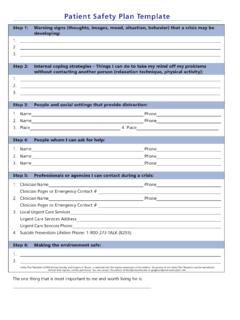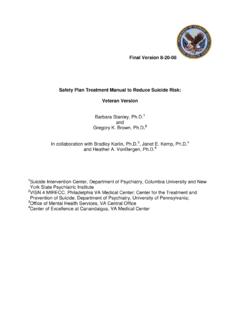Transcription of QUALITY IMPROVEMENT STUDENT PROJECT …
1 1 QUALITY IMPROVEMENT STUDENT PROJECT proposal : improving HANDOFFS IN SAN FRANCISCO GENERAL HOSPTITAL S EMERGENCY DEPARTMENT TMIT STUDENT Projects QuickStart Package 1. BACKGROUND Setting: Emergency departments are high-risk contexts; they are over-crowded and overburdened, which can lead to treatment delays, patients leaving without being seen by a clinician, and inadequate patient hand-offs during changing shifts and transfers to different hospital services (Apker et al., 2007). This PROJECT will focus on the Emergency Departments in county hospitals, specifically San Francisco General Hospital. SFGH has the only Trauma Center (Level 1) available for the over million people living and working in San Francisco County (SFGH website) Health Care Service: This paper will focus on intershift transfers, the process of transferring a patient between two providers at the end of a shift, which can pose a major challenge in a busy emergency department setting.
2 Problem: According to the Joint Commission on Accreditation of Healthcare Organizations (JCAHO), poor communication between providers is the root cause of most sentinel events, medical mistakes, and near misses. Furthermore, a recent survey of 264 emergency department physicians noted that 30% of respondents reported an adverse event or near miss related to ED handoffs (Horwitz, 2008). A similar survey notes that of hand-offs occur in a common area within the ED, of respondents stated that there was no uniform written policy regarding patient sign-out, and of those surveyed reported that physicians sign out 2 patient details verbally only (Sinha et al., 2007). At SFGH, handoffs occur in the middle of the ED hallway, usually next to a patient s gurney. Sign-out is dependent on the Attending and Residents on a particular shift; thus, it is non-uniform, and hand-offs are strictly verbal.
3 Barriers to QUALITY : In a 2005 article in Academic Medicine, four major barriers to effective handoffs were identified: (1) the physical setting, (2) the social setting, and (3) communication barriers. Most of these barriers are present during intershift transfers at SFGH. The physical setting is usually in a hallway, next to a whiteboard, never in private. Presentations are frequently interrupted, and background noise is intense from the chaos of an overcrowded emergency room. Attendings frequently communicate with each other and assume that the resident can hear them. Solet et al. suggests that Residents are unlikely to ask questions during a handoff if the information is coming from an Attending physician. All transfers are verbal, none are standardized, and time pressures are well known, since sign-out involves all working physicians in the ED at one time.
4 2. THE INTERVENTION The Institute for Health Care IMPROVEMENT (IHI) lays out several steps for conducting a QUALITY IMPROVEMENT PROJECT . First, an organization needs to explicitly state what they are trying to accomplish by setting time specific and measurable aims (IHI website). Next, an organization needs to establish measures that will indicate whether the IMPROVEMENT works. Changes that result in an IMPROVEMENT need to be identified and then tested in a Plan-Do-Study-Act (PDSA) cycle. Specifically, the change needs to be planned, tried, studied, and then members must act on what they have learned (IHI website). PDSA cycles should start out in a small group before being tried in a large institutional setting. Finally, the changes should be made throughout the institution. 3 Most projects that use rapid PDSA cycles to address issues with patient handoffs measured their compliance with a standardized communication method.
5 Programs such as the Five Ps (Patient, Plan, Purpose, Problems, Precautions), I PASS the BATON, or SBAR, are all acronyms for a standardized, tested procedure to ensure compliance with the Joint Commission requirements (Runy, 2008). Such methods may standardize the handoff process, but may not be considered the most efficient tool by providers; therefore, provider satisfaction is a key component for compliance and implementation (Wilson, 2007). Process defect: This PROJECT will attempt to address non-uniform patient handoffs at the SFGH ED by using rapid PDSA cycles to implement the SBAR handoff technique: - S-ituation: complaint, diagnosis, treatment plan, and patient s wants and needs - B-ackground: vital signs, mental and code status, list of medications and lab results - A-ssessment: current providers assessment of the situation - R-ecommendation: pending labs, what needs to be done (H&HN, 2008) Aim (Objective): to improve patient safety, content reliability, and peer satisfaction with SFGH ED handoffs by having 100% compliance of the SBAR standardized protocol within 18 months (adapted from Owens et al.)
6 , 2008) 3. STRATEGY FOR IMPLEMENTATION The first step of this implementation strategy will be to identify the early adopters and process owners. A small team, perhaps of one attending and two residents that are passionate about this PROJECT need to be identified and initiate the first PDSA cycle using the SBAR format for patient handoffs. In this small group, they can work out their pit-falls, and adapt the SBAR technique to the physical setting and social setting at SFGH. This group may wish to develop an index card with an SBAR template to improve communication. The first PDSA cycle may look something like this: 4 - Plan develop a strategy to reduce noise and distractions, use SBAR (perhaps with an index card that can be passed on), and have opportunity to ask questions. - Do early adopters need to try out the process during two changes of shift.
7 - Study evaluate satisfaction, review pitfalls, was it easy to comply? - Act Implement changes during next two changes of shift. Next, this group will need to identify opinion leaders within the organization, perhaps the Chief Resident, to help convince the early majority that this technique will improve patient safety and save time and effort during changes of shift. The early adopters may want to hold a training to convince this larger group. Next, this larger group will initiate its own PDSA cycle, until 100% compliance with the SBAR protocol is achieved. Measures: (a) compliance with the SBAR format, via an all or none metric, (2) provider satisfaction via survey, which will include questions on perceptions of time saving. Barriers to change: The major barriers to change will be from opinion leaders within the SFGH ED that want to protect the status quo.
8 Some Attending and Resident physicians may be wary of a new technique for fear that it may add to the amount of time it takes at the change of shift. Second, most of these physicians have always signed-out this way and have never had a problem. Once the early adopter group has worked out many of the kinks in implementation, leadership will play a key role for further adoption of this PROJECT . Leaders may take note of the Joint Commission s recommendation on handoffs (JCAHO, 2006), and support this PROJECT , and help nudge the late adopters along. However, in the long run, provider satisfaction of the protocol, including provider s perceptions of saving time, will dictate adherence, so even late adopters need to have input during PDSA cycles. 5 Simple Rules: The landmark IOM report Crossing the QUALITY Chasm identified 10 simple rules to help redesign health care processes (IOM, 2001).
9 This QUALITY IMPROVEMENT PROJECT is in accordance with rule ten: cooperation among clinicians. Clinicians should actively collaborate and communicate to ensure and appropriate exchange of information and coordination of care. Standardizing patient handoffs in a busy emergency department setting is crucial to patient safety and helps place patients needs first; this change manifests this simple rule. Cost implications: This process change does not require any additional costs. REFERENCE Apker et al. (2007) Communicating in the gray zone : perceptions about emergency physician-hospitalist handoffs and patient safety. Aca Emerg. Med. 14(10), 884-94 Coleman et al. (2004) Lost in Transition: Challenges and Opportunities for improving the QUALITY of Transitional Care, Ann Intern Med. 140:533-36. Horwitz et al.
10 (2008) Dropping the Baton: A qualitative analysis of failures during the transition from emergency department to inpatient care. Annals of Emergency Med. Article in press, accessed April 21, 2009 Horwitz et al. (2009) Evaluation of an Asynchronous Physician Voicemail Sign-out for Emergency Department Admissions. Annals of Emergency Med. In press, accessed April 21, 2009. IHI website. IMPROVEMENT methods-PDSA cycle. accessed April 29, 2009. Institute of Medicine (IOM). Crossing the QUALITY Chasm. Washington, DC: National Academy Press, 2001. Joint Commission on Accreditation of Healthcare Organizations. Sentinel event root causes. Jt Comm Perspect Patient Saf. 2005; 5(7):5 6. JCAHO. improving Handoff Communications: Meeting National Patient Safety Goal 2E. Joint Perspectives on Patient Safety. 2006; 6(8): 9-15.








